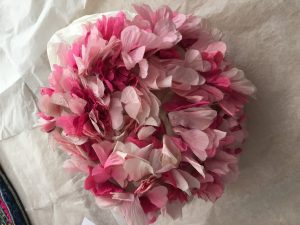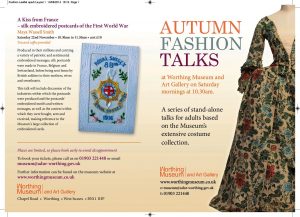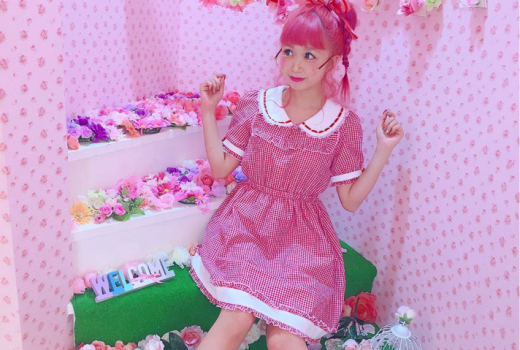Second year Fashion and Dress History student Donna Gilbert on researching a hat in the University’s Dress History Teaching Collection

Fig 1: Woman’s cocktail hat, late 1950s, early 1960s. Silk petals on a silk organza base. University of Brighton Dress History Teaching Collection, Pavilion Parade, Brighton. Personal photograph by the author. 16 Feb 2018.
As part of our second year Constructing Histories module, we were asked to write a catalogue entry based on one of a range of items selected from the Special Collection at St Peter’s House Library and the University of Brighton Dress History Teaching Collection. As a Fashion and Dress History student, my eye alighted on a frivolous pink silk flower hat, illustrated in figs 1 and 2, which perfectly summed up the femininity and impracticality of one of my favourite eras for fashion, the 1950s.

Fig 2: Woman’s cocktail hat, late 1950s, early 1960s. Silk petals on a silk organza base. University of Brighton Dress History Teaching Collection, Pavilion Parade, Brighton. Personal photograph by the author. 16 Feb 2018.
Hats used to be such an important fashion accessory; in the Edwardian era no woman, whatever her class, would dream of going out without a hat or bonnet. By the 1950s fashion had become increasingly informal but women were still expected to wear a hat for church and social occasions such as weddings, christenings and graduations. Veiled hats and floral cocktail hats were popular in the late 1950s and early 1960s and featured in the collections of several of the major French couturiers, including Balenciaga and Christian Dior.

Fig 3: c.1950s ‘Coquette Original’ evening dress. Photo: PP-Photography.
‘Franck et Fils’ department store
This silk flower hat features the label ‘Franck Modes, Paris’ and is assumed to have come from ‘Franck et Fils,’ an exclusive Parisian department store.[1]Emma Franck opened ‘Les Galeries Parisiennes,’ her first mercerie, or haberdashers in 1897, selling fabrics, ribbons and original hats and incorporating a workshop which would quickly complete client’s orders.[2]After World War One the store became ‘Franck et Fils,’ dedicated entirely to women. The Franck Modes cocktail hat features silk petals designed to resemble sweet-peas (Lathyrus Odoratus).These are glued to a silk organza base, which features darts for shaping, and hand-stitching. The fact that the flowers are glued indicates that the hat was produced for the ready-to-wear market, rather than couture.
The silk flower industry
What particularly interested me about this hat was the manufacture of the silk petals. This was something that had intrigued me since I came across a 1950s ‘Coquette Original’ evening dress, illustrated in fig 3, which had leaves imprinted with veins (fig. 4) on the bodice and cascading down the front. I was curious to know how these had been achieved.
Silk flowers have been produced in Europe since the eighteenth century and are manufactured using traditional processes which are highly skilled and time-consuming. The silk is attached to a frame and then dropped into a gum, starch or flour bath to ‘dress’ it. The fabric is then layered in a cutting press and each flower-type has its own punch to cut the petal shapes. This was physically demanding work and mostly carried out by men. Once cut, the silk petals would be hand-coloured. After the initial colouring a second colour is applied to produce the shaded effect, bleeding off the edge of the petals.[3]When the petals are dry, they can be pressed in special moulds which imprint them with the veins and texture. Brass tools are then used to shape them. These are heated over a flame until they are hot enough to gently mould the petals into flower shapes. These traditional techniques continue to be used today by skilled manufacturers.
The silk flower industry was huge up until World War One, with women from all classes donning flower bonnets and hats. The 1891 census reported 4011 silk-flower makers in London alone, but the flowers were often produced in appalling conditions. The Children’s Employment Commission of 1865 found that most women assembling the flowers were under eighteen years of age, and some were as young as eight. Factories had them working between twelve and eighteen hours a day.[4]The disruption of war and changing fashions had a huge impact on the flower-making industry and many houses closed. The popularity of floral hats declined during the 1960s and since the 1970s, cheap artificial flowers from the Far East have infiltrated the market.

Fig 4: Leaf detail on bodice of ‘Coquette Original’ evening dress, illustrating the imprinting of the leaf veins. Personal photo by the author.
The silk flower hat highlights a period in history when women were bound by social mores and the wearing of hats, at least for social occasions, was expected. During the 1960s these expectations were relaxed and hat-wearing amongst both men and women became a matter of choice rather than convention.
[1]“Franck et Fils”, France Today.Web. 16 Feb 2002. www.francetoday.com/culture/shopping-boutiques/franck_et_fils
[2]Celine Vautard, “Franck et Fils: The end of an Institution in the district of Passy,” Fashion United, 3 June 2016. Web. fashionunited.fr/actualite/retail/franck-fils-la-fin-d-une-institution-du-quartier-de-passy/
[3]“The House of Legeron – History”. Web. http://www.boutique-legeron.com/en/37-history
[4]Beatrice Behlen and Natasha Fenner, “The lost art of flower-making,” Curators, The Art of Flower-Making Display, 3 March 2016. Web. www.museumoflondon.org.uk/discover/lost-art-flower-making.
























